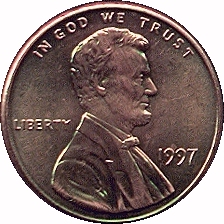Flipping a coin in the air, catching it, then determining whether it has come up heads or tails is a common way to start off a game or settle a question. Because you expect that heads is as likely to come up as tails, it sounds like a fair way to make a choice.

But coin tossing isn’t really random at all. A mechanical gadget can flip a properly positioned coin so that the coin always lands showing the same face. Some magicians can make a coin come up heads on every toss—even when they don’t use a two-headed coin.
A new mathematical analysis now suggests that, in a typical toss, a coin is more likely to land on the same face as it started out on (see Toss Out the Toss-Up: Bias in heads-or-tails).
Research interest in the fairness of coin tosses goes back many years. In 1985, physicists Valdimir Z. Vulovic and Richard E. Prange of the University of Maryland developed what they described as a physically realistic mathematical model of a coin toss.
The physicists argued that coin flipping obeys Newton’s laws of motion. Each flip depends on the impulse given the coin by the thumb and the height above the floor from which the coin starts. If you could know the impulse given by the thumb in a particular case or had a stable mechanical flipper, you could then predict how the coin would fall. Any randomness would be not in the flipping itself but in how precisely the starting conditions are known.
In the physics of coin tossing, the most important parameters are the coin’s upward velocity and its rate of spin. When the spin rate is low, the coin acts like a thrown pizza. It’s unlikely to turn over, even if it travels a long distance.
A coin may also come down without flipping over if it doesn’t go high enough—even when it’s spinning very rapidly. There would be too little time for the coin to turn over.
By calculating how often a coin turns over for a certain spin and upward velocity, one can predict whether it will come up heads or tails. The outcomes for a range of spins and velocities can be plotted on a graph. Such a graph reveals that for the spins and velocities typically encountered in coin tosses, tiny changes in initial conditions make the difference between heads and tails.
Thus, coin tossing is almost random. A look at the spread in the way real people flip real coins indicates that heads and tails would each come up about half the time.
Around the same time, mathematician Joseph B. Keller of Stanford University performed a similar analysis. He assumed that a toss involves throwing a coin so that it spins perfectly around a horizontal axis through the coin’s center.
Keller showed that, for large values of the initial velocity, the sets of initial velocity values that lead either to heads or to tails are of equal size for a fair coin. Thus, half of the initial conditions lead to heads and half to tails.
Both of these analyses, however, ignored the fact that a tossed coin may also wobble, spinning around a tilted axis and precessing like a top. Wobbling introduces additional subtleties that end up biasing the results of coin tosses.
The bias isn’t large, but recent experiments show it’s there. Because it’s very difficult to toss a coin “perfectly,” this bias comes into play for just about any given coin toss.






